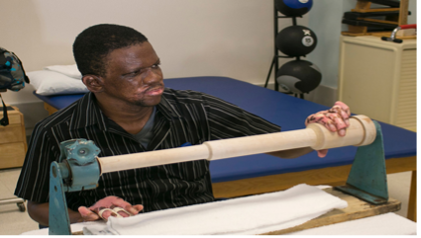Occupational therapy practice with burn injuries: A Rapid Review
DOI:
https://doi.org/10.17159/2310-3833/2024/vol54no1a10Keywords:
intersectoral burn injury intervention,multidisciplinary rehabilitation, pressure garment, splinting, systematic review, randomised control trail, psychosocial functioning, occupational engagement, intersectorial burn injury intervention, multidisciplinary rehabilitation, pressure garments, splinting, systematic review, randomised control trial, psychosocial functioning, occupational engagementAbstract
Introduction: The Occupational Therapy Association of South African commissioned a task team to gather evidence that would inform upcoming National Health policies on the role and practice of occupational therapists. This rapid review aimed to identify level 1 and 2 peer reviewed published evidence that describes occupational therapists’ practice and intervention in all types of burn injuries, at all levels of care, and for all age groups.
Method: Using the South African Department of Health template and the Cochran Rapid Reviews method guide, a search for level 1 and 2 evidence sourced articles from CINAHL (EBSCO), MEDLINE (EBSCO), the Cochrane Library (Wiley) and OTSeeker data bases through the Stellenbosch University library with hand searching of references in the selected articles. Rayyan was used for the screening and selection of articles. The CASP appraisal tool was used for risk bias and quality assessment of the selected articles. Data was captured in Excel and Word, and analysed and synthesised in Microsoft Excel and Taguette. Results were presented in the form of an online workshop to stakeholders and discussions and questions incorporated into the discussion and conclusion of this review.
Results: Eleven articles were selected and their quality assessed. Seven categories of evidence of occupational therapy interventions were extracted from selected articles: pain, oedema, scaring and abnormal skin sensations, joints and range of motion, psycho-social and functional impact of burn injuries, the education of burn injury victims and their families, and vocational rehabilitation. All interventions took place in healthcare facilities. Nine articles referred to occupational therapists working in multi-disciplinary teams. Occupational therapist worked with children and adult burn injury victims and with a variety of type of burn injury from acute to post discharge phases.
Conclusion: There is level 1 and 2 evidence conderming occupational therapy intervention with burn injury victims with all ages and at all stages of injury within healthcare facilities. None of the evidence found is from the South African context. Such levels of evidence are needed to promote occupational therapy intervention in primary, preventative and community contexts.
Implications for practice:
Internationally there is level 1 and 2 evidence that conderms occupational therapists are members of multi-disciplinary teams addressing the functional ability and participation in activities of burn injury victims. None of this evidence is from South Africa. As a matter of priority, South African clinical occupational therapy practice and intervention within the deeld of burn injury, need to be researched and disseminated as level 1 and 2 evidence
Downloads
References
See PDF for full list of references

Downloads
Published
Issue
Section
License
Copyright (c) 2024 South African Journal of Occupational Therapy

This work is licensed under a Creative Commons Attribution-NonCommercial-NoDerivatives 4.0 International License.
How to Cite
- Abstract 366
- PDF 232
- PLAGIARISM Report 34



.png)